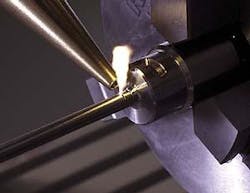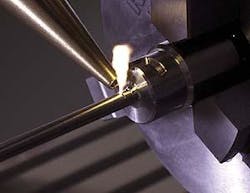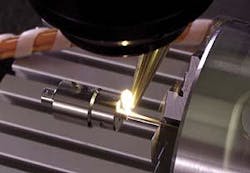Laser technologies in medical device manufacturing
F. Bachmann,* D. MaierhÖrmann,** A. May,*** T. Renner,** and R. Hendel****
Lasers used in the manufacture of medical devices—primarily for fine welding, cutting and marking—meet the needs of manufacturers by miniaturizing materials processing
The controllability and cleanliness of laser processes make the laser an ideal tool for integration into automated systems or production lines. If a mechanical metal cutter such as a reamer or diamond rotary blade is replaced with a laser, then the need for lubricating fluids is eliminated and dust is reduced. Replace an ink-jet printer with a laser marker and the product can be permanently identified without contamination; inks can be eliminated from cleanroom production areas.
Fine cuttingThe CO2 laser, best known for sheet metal cutting, has a wavelength of 10.6 µm and can only achieve spot diameters (cutting width) of 50-70 µm and above. The medical industry is looking for much finer results; with 10 times shorter wavelength (1.06 µm) than CO2 lasers, the Nd:YAG laser can theoretically achieve a focused laser spot of around 3 µm.A coronary stent acts as a tiny 'scaffold' to support internal artery walls, when expanded using balloon angioplasty. A TEM00 mode Nd:YAG laser cuts submillimeter-diameter tubes with a kerf width down to 15-20 µm, without damaging the opposite inside walls of the stent (see Figure 1).
Recently, tube diameters down to 0.5 mm OD have been cut—this opens up new possibilities for new products. The minimal HAZ of less than 3 µm in typical steel material is another advantage of the Nd:YAG lasers, allowing the cutting of drills and saws for surgical instruments. By using inert shield gas there is no melting at corners during the cutting process, and the teeth cut are so sharp and clean that almost no post treatment is necessary.
Pulsed Nd:YAG lasers are available up to 500 W. For tube cutting, turnkey two-axis systems are available. For flat and three-dimensional parts, up to five-axis precision systems are available.
Fine weldingMany people are aware of laser welding applications in automotive and other industries. However, few people realize that the laser improves the welding process with the ability to minimize the HAZ that most other types of welding processes cannot achieve. Hence, medical device manufacturing has become one of the most successful industries to realize this improvement.Both metals and polymers can be welded using pulsed Nd:YAG lasers. Typically, these lasers have an average power of between 20Ωand 500Ωwith pulse energies of up to 100 J.
The small HAZ and the smooth surface finish produced by laser welding is essential for antiseptic conditions. Most conventional welding technologies reach their limit when welding titanium or titanium alloys. Surprisingly, laser welding achieves some of its best results when welding titanium and its alloys (see Figure 2).
Typical examples where lasers are already used in medical applications are in such devices as pacemakers, endoscopes, brain clamps, implants and so on. A variety of different laser solutions can be applied ranging from manual welding stations to fiber-delivered semi- or fully automated systems (also incorporated into gloveboxes).
Small, efficient, cost effective and reliable diode lasers at 800-1000 nm weld polymer materials that are normally transparent in the near infrared spectral region by the addition of special materials that absorb diode laser radiation (such as carbon black, special pigments or dyes). The thermo-mechanical behavior of thermoplastic polymers differs considerably from the behavior of metals. Metals show a clear transition at certain temperature from the solid to the liquid state and from the liquid to the vapor phase. Thermoplastic polymers start melting at the so-called glass temperature and slowly reduce viscosity with increasing temperature up to the melting point. At higher temperatures polymers would rather start decomposing than vaporizing. The viscosity of the heated polymers is still high compared to melted metals, so that material does not flow without external force; moreover, thermal conductivity of polymers is much lower than thermal conductivity of metals.
As a consequence, the ideal configuration for polymer welding with a laser is the overlap weld. To bring the energy at the joining area, a layer that is transparent for the laser and a layer that strongly absorbs the laser light must be provided.
The process has several advantages over the conventional vibration, ultrasonic or adhesive technologies: There is normally no thermal impact on any surface, no debris or bulge is generated, the method is flexible and it is environmentally friendly. Depending on material and product design, welding speeds as fast as 10 m/min can be reached at a moderate laser power of less than 100 W.
Polymer welding with lasers is successfully used in the electronics industry and is now in an evaluation phase in medical device manufacturing. The challenge at the moment is to investigate the material properties and pigmentation of the materials, so as to make it suitable for laser welding and meet the strict requirements in medical device manufacturing.
MarkingLaser marking is everywhere today, with thousands of industrial companies putting the technology to use. The medical field is no different—metal and plastic surgical implants have long been marked using almost exclusively laser; plastic components for testing kits and drug delivery mechanics have batch codes, scales and dial numbers created by laser; sell-by dates are etched onto drug packaging. In common with other industries, medical device and pharmaceutical businesses turn to lasers for a one-step, fast, flexible, permanent and a highly automated marking process.But drug packaging and medical fields see even more attractions in laser marking: cleanliness, anti-counterfeiting and resolution of mark are also important. Components that demand a high degree of traceability may need barcodes to permanently identify them in subsequent automated tracking processes. These codes must have the capacity to contain large amounts of information, such as batch or serial numbers, part numbers and place/date of manufacture information. Often space is exceedingly limited, so the laser's ability to mark highly resolved ID matrix codes is valuable. These 2D barcodes facilitate marking of codes containing 20 or more characters onto spaces only a few millimeters across.
Alternatives to laser marking onto metal, ceramic or plastic parts in medical fields often compare unfavorably: ink jet, hot foil and screen printing all involve addition of other compounds, which cannot be tolerated in the case of marks on implants or invasive surgical tools. Even on less critical surfaces such as marks on packaging or dispensing products, these containers are often filled in clean environments. Such manufacturing/ filling environments simply do not suit processes that use inks and solvents, so laser is preferred.
With the recent new developments in industrial lasers requiring long runtime hours, laser markers have become the choice in highly automated high-volume production lines that can be installed and then serviced infrequently—typically once or twice a year. Diode-pumped solid-state (Nd:YAG) lasers show a 10-fold increase in the pump medium's lifetime to 10,000 operating hours. Gas (CO2) lasers can be designed as sealed 'slabs' eliminating gas bottles entirely. Compare this to other technologies, which require regular monitoring and refilling, and stock control mechanisms to ensure consumables are always available.Laser marking in the medical device field is becoming the method of choice as a means of meeting the authorities' requirements for clean, permanent, traceable identification of product.
The authors are with *Rofin-Sinar GmbH, **Rofin/Baasel Lasertech, ***Rofin-Baasel UK and ****Rofin-Sinar Inc. USA. Contact Richard Hendel at Tel. (734) 416-0208 or visit www.rofin.com


